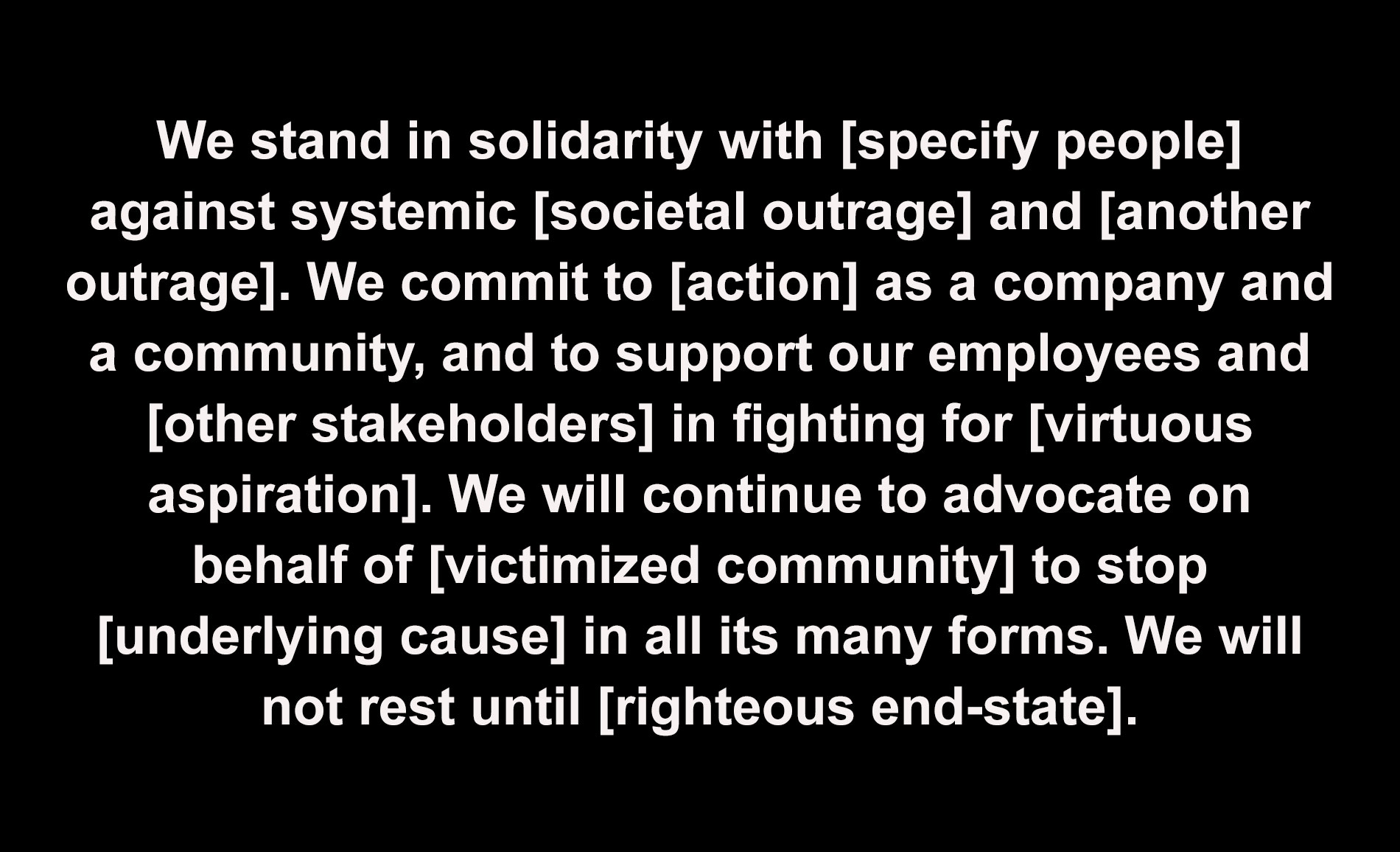The unmasking of Corporate America
Joel Makower
Mon, 06/15/2020 – 02:11
The past two weeks have seen an outpouring of concern and commitment by companies about racism in the United States. Pronouncements on company social media accounts often take the form of graphics — white type against a black background seems to be de rigueur in the current environment.
It’s all a welcome sign but also treacherous territory. For one simple reason: Words, no matter how compelling, compassionate or committed, aren’t enough to undo the injustices and structural challenges employees and others face when it comes to race and equity. Companies are being asked to show, not just tell. And hypocrisy, or lack of action, is being called out.
Consider the backlash already on social media. As companies post their support for Black Lives Matter and racial justice in general, activists are asking these companies to also post a picture of their leadership team and/or board of directors.
Words, no matter how compelling, compassionate or committed, aren’t enough to undo the injustices and structural challenges employees face when it comes to race and equity.
You can probably guess why: Corporate board and leadership teams are all too often overwhelmingly white and male. And while gender diversity has improved significantly over the past few years — according to Institutional Shareholder Services, 45 percent of new board positions among the Russell 3000, representing 3,000 of the largest U.S.-traded stocks, were filled by women in 2019, up from just 12 percent in 2008 — racial diversity has not.
According to the 2019 Registry of Corporate Directors published by Black Enterprise magazine, there were just over 300 African-American board members among S&P 500 companies, out of nearly 4,500 board seats overall. That’s progress, but barely. (Full disclosure: GreenBiz Group’s six-person leadership team, four men and two women, is all-white.)
Board seats and leadership positions are only one aspect of corporate performance on diversity and inclusion, but it’s a critical one, as modeling behavior starts at the top.
Companies are responding in a range of meaningful ways: devoting tens of millions of dollars to racial justice initiatives (Apple, Google, NBCUniversal), establishing an internal committee to advance racial equity and justice solutions (Walmart), committing that black candidates are on the succession list for all senior-level positions (Estée Lauder), as well as pledging to direct more investment capital to minority entrepreneurs, publicly advocating for action at the state and local levels, and developing anti-racist workplace initiatives, among other things.
But there are also corporate statements that risk being seen as window dressing. Take the Business Roundtable, a group of companies whose 2019 Statement on the Purpose of a Corporation has received copious press coverage. Earlier this month, the group tapped seven of its board members to form a committee on “racial equality and justice solutions.”
Critics pointed out that there are no specific benchmarks or funding. The committee is led by two black and five white executives from Eaton, Vista Equity Partners, AT&T, Marriott International, General Motors, JPMorgan Chase and Johnson & Johnson. Most of these companies have no more than two people of color on their boards. …
A spokeswoman for the Business Roundtable said the group is “committed to taking thoughtful action on issues of racial injustice,” which includes “CEOs listening to their employees, customers and members of the communities they operate in, with the goal of strengthening unity and justice.” The spokeswoman also noted that 19 of the group’s more than 180 CEOs are people of color, while another 19 are women (just one of whom is nonwhite).
Which begs the question, not just for the Business Roundtable but for all companies: What actually will change as a result of these statements and commitments? How will progress be measured and tracked? Who will be holding companies accountable?
Probably not Wall Street.
“Your standard research analyst is not going to ask, ‘Please articulate your efforts to become an anti-racist, multicultural organization,’” Erika Karp, founder and CEO of Cornerstone Capital and a Wall Street veteran, told me last week. “You’re not going to hear that on an analyst call.”
She added: “But I think you should.”
I asked Karp, whose firm published a 2018 research report, “Investing to Advance Racial Equity,” how she’d like to see companies judged, and whether company actions could be boiled down to the kind of environmental, social and governance metrics analysts are coming to expect from publicly traded companies.
Instead, Karp pointed me to an undated, but presumably recent, matrix pulled from the psychoanalytic world: “Continuum on Becoming an Anti-Racist, Multicultural Institution.” It plots companies across six stages, from Exclusive (“a segregated institution”) to Fully Inclusive (“a transformed institution in a transformed society”). The continuum tracks companies from monocultural to multicultural to anti-racist to anti-racist multicultural.
Most companies, from my perspective, can be found in the early stages of the continuum, such as Passive (“tolerant of a limited number of people of color with ‘proper’ perspective and credentials”) and Symbolic Change (“makes official policy pronouncements regarding multicultural diversity”). The tougher stuff is yet to come.
Said Karp: “This came from the psychoanalytic world, but it might as well be from McKinsey.”
In many ways, we’ve seen this movie before. The anti-racist continuum could be applied, with only modest modification, to corporate sustainability or social responsibility, from reactive and recalcitrant polluters at one end, to proactive and regenerative beacons at the other.
And, as with sustainability, how a company is perceived on racial justice and equity is a delicate dance between showing and telling — that is, meaningful actions paired with stories, with great care given to not let the latter get too far ahead of the former. When the two are unaligned is when companies find themselves called out on social media and beyond.
For most companies, having an open dialogue is a critical first step, but if things don’t progress from there, it will be more than a lost opportunity — it increasingly will become a risk factor.
That’s a lesson of this moment: Be careful out there. Show, don’t just tell.
I invite you to follow me on Twitter, subscribe to my Monday morning newsletter, GreenBuzz, and listen to GreenBiz 350, my weekly podcast, co-hosted with Heather Clancy.
Diversity

GreenBiz Group


